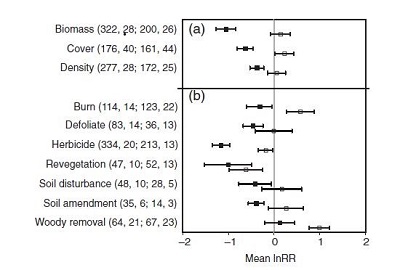A systematic review of cheatgrass (Bromus tectorum) control research
A systematic review of cheatgrass (Bromus tectorum) control research
(Thomas Monaco, Jane Mangold, Brian Mealor, Rachel Mealor, and Cynthia Brown)
Download Weed Post on A systematic review of cheatgrass as PDF (includes word puzzle)
Introduction
Cheatgrass is one of the most significant invasive plants on western rangelands. Because cheatgrass has been problematic for decades, a relatively large body of research exists compared to more recent invaders. When such a large body of research is available, its thorough review provides an opportunity to compare relative efficacy of different control methods to identify promising strategies and future research needs.
Methods
We systematically reviewed all peer-reviewed, published journal articles spanning a 64-year period (1948-2012) that reported data on efforts to directly or indirectly reduce cheatgrass abundance on rangeland in the western U.S. Simultaneously, we assessed how such efforts affected abundance of perennial grasses since an increase in perennial grasses is usually desired by land managers who are dealing with cheatgrass infestations. Effect sizes were calculated and used to quantify the magnitude and direction of a treatment. Effect sizes <0 indicated a decrease in cheatgrass abundance while positive effect sizes indicate an increase in cheatgrass abundance.

Figure 1. Cheatgrass abundance (a) pooled across all control methods and (b) by individual control method (pooled across measures of abundance). Symbols represent mean effect sizes 1 year after treatment (solid) and ≥2 years after treatment (open). Mean effect sizes are considered significant if confidence intervals do not overlap the vertical zero-line. Values to left of zero-line indicate a decrease in cheatgrass abundance while values to the right indicate an increase. Numbers in parentheses indicate sample sizes and the number of articles from which short- and long-term responses were acquired, respectively
Results
Our literature search produced 119 articles that underwent further quantitative review. The seven most common control methods studied were herbicide (55%), burning (29%), revegetation (29%), woody plant removal (21%), defoliation or grazing (16%), soil disturbance (13%), and soil amendment (8%). Most articles (58%) only evaluated one control method, followed by two-method combinations (38%). Most studies occurred on small plots (<1m2) that were monitored for less than five years, and control methods were typically applied only once. Pooled across all control methods, cheatgrass abundance (biomass, cover, density) was reduced in the short-term (1 year post-treatment), however cheatgrass abundance was unaffected compared to non-treated areas over the long-term (≥2 years post-treatment) (Figure 1a). Similarly, pooled across all measures of abundance, all control methods reduced cheatgrass in the short-term except woody plant removal (Figure 1b). Revegetation and herbicide were the only control methods to provide long-term reduction in cheatgrass.
Conclusions
An initial decrease in cheatgrass followed by an increase over time, and in contrast an initial increase in perennial grasses followed by a decrease over time, suggests successful management will require reductions in cheatgrass over a long enough period in order for desirable resident species to recover or seeded species to establish. Extrapolating our results to management are limited because 1) most studies in our review occurred in areas where cheatgrass has had long-term and large-scale impacts (i.e. Great Basin) as opposed to areas where cheatgrass is a more recent invader and 2) most studies rarely applied a control method more than once or to an area >2.5 acres in size, which does not represent what typically occurs on western rangeland. Future research should explore how to prevent re-invasion, control methods that provide greater residual control of cheatgrass, and occur on larger temporal and spatial scales. Read more at Monaco et al. 2017 abstract.Many cheatgrass control methods resulted in an increase in perennial grass abundance over the short-term; burning, herbicide, and soil disturbance resulted in long-term increases in perennial grasses (data not shown). Herbicide was the only method that both decreased cheatgrass and increased perennial grasses over the long-term.
